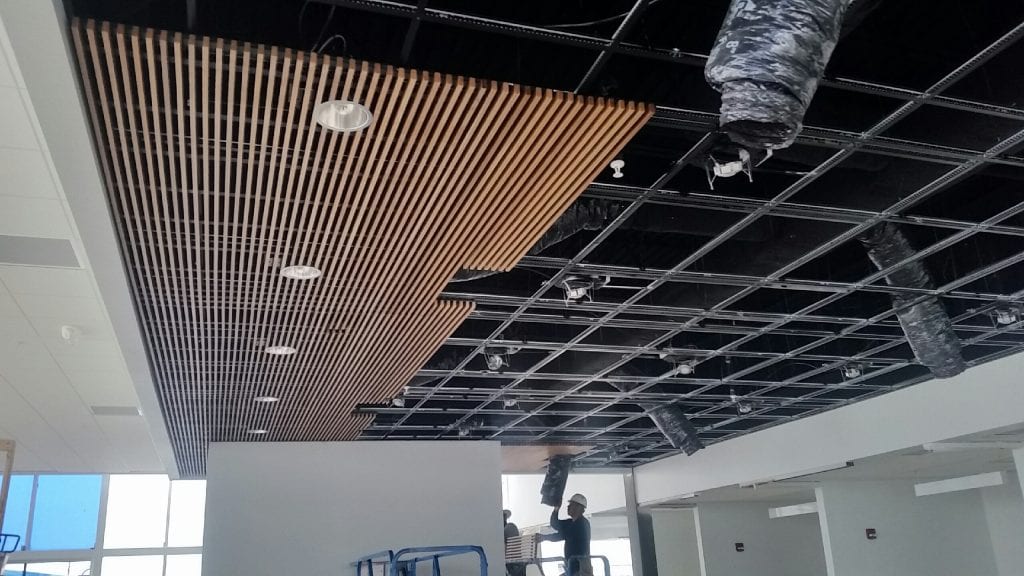When it comes to choosing the right ceiling for your space, the decision often boils down to suspended ceilings and traditional ceilings. Each option comes with its own set of advantages and drawbacks. In this comparison, we’ll explore the pros and cons of suspended ceilings (also known as drop ceilings) versus traditional ceilings to help you make an informed choice for your project.
Suspended Ceilings: Pros and Cons
Pros:
- Easy Access to Utilities:
- Pro: Suspended ceilings provide easy access to electrical wiring, plumbing, and HVAC systems. Ceiling tiles can be removed, allowing for convenient maintenance and repairs.
- Acoustic Benefits:
- Pro: Suspended ceilings can enhance acoustics in a space by absorbing sound, making them suitable for environments where noise control is important.
- Aesthetic Versatility:
- Pro: A wide variety of ceiling tile designs, colors, and textures are available, allowing for creative and customizable aesthetic choices.
- Concealment of Imperfections:
- Pro: Suspended ceilings can hide imperfections in the existing ceiling, providing a smooth and uniform appearance.
- Energy Efficiency:
- Pro: Some suspended ceiling materials offer additional insulation, contributing to energy efficiency by helping to regulate temperature.
Cons:
- Limited Height:
- Con: Suspended ceilings may reduce ceiling height, which can be a drawback in spaces where maximizing vertical space is crucial.
- Aesthetic Limitations:
- Con: While there are many design options, some may find suspended ceilings less aesthetically appealing than traditional ceilings.
- Installation Complexity:
- Con: Installing a suspended ceiling requires careful planning and attention to detail, and it may be more complex than installing a traditional ceiling.
- Cost:
- Con: The upfront cost of materials and installation for suspended ceilings can be higher compared to traditional ceilings.
- Maintenance Overhead:
- Con: Over time, suspended ceilings may require more maintenance, as tiles may need to be replaced or cleaned.
Explore more about Tallyman Axis and get updated.
Traditional Ceilings: Pros and Cons
Pros:
- Aesthetic Appeal:
- Pro: Traditional ceilings often have a classic and timeless aesthetic appeal, enhancing the overall look of a space.
- Height and Spaciousness:
- Pro: Traditional ceilings can provide a sense of openness and spaciousness, making them ideal for rooms where a lofty feel is desired.
- Durability:
- Pro: Traditional ceilings, especially those made from durable materials like plaster, can be long-lasting and resistant to damage.
- Design Simplicity:
- Pro: Traditional ceilings are generally simpler to install and may require less intricate planning compared to suspended ceilings.
- Cost-Effective:
- Pro: Traditional ceilings often have lower upfront costs in terms of materials and installation compared to suspended ceilings.
Cons:
- Limited Access to Utilities:
- Con: Traditional ceilings can make accessing utilities for maintenance or repairs more challenging compared to suspended ceilings.
- Sound Reflection:
- Con: Traditional ceilings may reflect sound rather than absorbing it, potentially leading to less favorable acoustics in some spaces.
- Aging Appearance:
- Con: Over time, traditional ceilings may show signs of wear and aging, requiring more extensive renovations for a refresh.
- Installation Challenges:
- Con: Installing traditional ceilings can be labor-intensive, especially if intricate designs or molding details are involved.
- Insulation Limitations:
- Con: Traditional ceilings may not offer the same insulation benefits as some suspended ceiling materials.
Conclusion:
The choice between suspended ceilings and traditional ceilings ultimately depends on the specific needs, aesthetics, and functionality of your space. Consider factors such as access to utilities, acoustic requirements, design preferences, and budget constraints when making your decision. Each type of ceiling has its own merits, and the ideal choice will align with your project goals and the characteristics that matter most to you.









